Did you look at the title of this post and think you were going to get something along the lines of one of those glossy magazine articles on how to live fashionably on a budget by taking a single outfit from the office to the evening with the simple addition of a few well-chosen accessories? (You know, the ones where you start with one ridiculously-priced suit, replace the businesslike button-down blouse with a silk décolleté cami, add the diamond necklace, Fendi bag, and Blahnik stiletto slides, and you’re good to go? Bargain city.)
Sorry to disappoint, but this isn’t exactly that. It is the decidedly less glamorous story of how I made two breads with EXACTLY the same ingredients (no baker’s diamonds here), the first only so-so and the next a bit better, by paying closer attention and changing just a couple of things in my method.
I hope it’s obvious that the plump loaf in the photo above is the Better bread, while this flattened one is the So-So:
In case you’re not convinced, compare these slices:
So huh? Well for one thing, Bread So-So proofed too long. A big clue to this was that the dough was already starting to fall apart by the time I put it into the oven (see the breaks on the surface, between the slashes?) Virtually no oven spring was another tip-off.
By paying more attention the second time around, I was able to get Bread Better into the oven after a more appropriate proof time. The day I baked Better was considerably cooler than the first time around, so fermentation was slower, and the actual clock time was not all that much shorter. Taking temperature into account, though, I’d say So-So proofed about 50% more than Better.
My other mistake was being too slash-happy on Bread So-So. Too many, and too deep, which allowed the loaves to spread out excessively. A more moderate approach served Bread Better… well, better. (Note: on doughs with a very large proportion of whole wheat or rye flour it helps to slash before proofing, and to do it at a 90-degree angle to the surface of the loaf, rather than at an angle as for many other breads. Both So-So and Better got this treatment.)
Both breads tasted great, with an assertive sour flavor, moist (if dense – just the nature of the beast) crumb, and toothsome texture provided by the seeds.
Before the recipe, a note about the name/composition of this bread: The 1.6% white flour comes from the white starter I used to make the levain. If I were a purist, I would maintain a whole wheat starter in addition to my white one. Or at the very least I would have exercised a modicum of advance planning and converted a portion of my white starter to whole wheat a few days before making the bread. I often do that, but I didn’t for these. Sosumi.
98.4% Whole Grain Seeded Sourdough
Yield: 1.1 kg (2 loaves)
Time:
- Ferment levain and soak soaker: 8 – 12 hours
- Mix final dough: 15 minutes
- First fermentation : 1.75 – 2 hours, with a fold at 45 minutes
- Divide, preshape, and rest: 35 minutes
- Proof: 1 – 1.5 hours (or until done)
- Bake: 40 minutes
Desired dough temperature: 77F
Levain Ingredients:
- 18 g ripe 100% hydration white starter
- 91 g whole wheat flour
- 73 g water
Soaker Ingredients:
- 21 g whole toasted flax seeds
- 21 g toasted sesame seeds
- 21 g bulgur
- 21 g rolled oats
- 79 g water
Final Dough Ingredients:
- 364 g whole wheat flour (I used Giusto’s organic)
- 90 g whole rye flour (I used 45 g Giusto’s organic and 45 g KAF organic pumpernickel)
- 346 g water
- 12 g salt
- All of the levain
- All of the soaker
- Wheat bran or seeds for topping
Method:
- In a medium bowl, mix the levain ingredients until just combined. Cover the bowl and let the levain ferment at room temperature for 10 – 12 hours.
- In a small bowl, combine the soaker ingredients. Cover and let rest for 2 – 12 hours.
- Place the final dough ingredients, except the soaker, into the bowl of a stand mixer. Mix on low speed until the ingredients are incorporated, about 4 or 5 minutes. The dough will be sticky and have a medium consistency.
- Continue mixing on low or medium speed until the dough reaches a medium level of gluten development. This might take about 5 minutes, but will depend on your mixer.
- Add the soaker and mix in low speed until it is just evenly incorporated into the dough.
- Transfer the dough to an oiled container.
- Ferment for 1.75 – 2 hours, with a fold after the first 45 minutes. The dough will increase about 50% in volume (honestly, I’m guessing here, I didn’t measure it) and be light and spongy, but without large gas bubbles.
- Divide the dough into two equal pieces of about 560 g each. Preshape the pieces into balls and let them rest, covered, for 30 minutes.
- Shape the dough into balls. Roll the top of each ball on a wet towel to hydrate it, then in bran or seeds.
- Place the loaves right-side-up in a couche. Slash each loaf about 1/2-inch deep, at a 90-degree angle to the loaf. Not too many slashes!
- Proof, covered, for 45 minutes to one hour (may be longer if the room or the dough is very cool). The loaves should have increased noticeably but not dramatically in volume, and feel light but not spineless when you rest the palm of your hand on the surface.
- Meanwhile, preheat the oven, with baking stone, to 475F. You will also need steam during the initial phase of baking, so prepare for this now.
- Once the loaves are in the oven, turn the heat down to 450F. Bake for 8 minutes with steam, and another 22 minutes or so without steam. Turn off the oven and leave the loaves in for another 10 minutes, with the door ajar for the last 5 minutes of this time.
- Cool on a wire rack. Wait until completely cool to cut and eat; best if you can wait at least 12 hours. To me it tastes best thinly sliced.
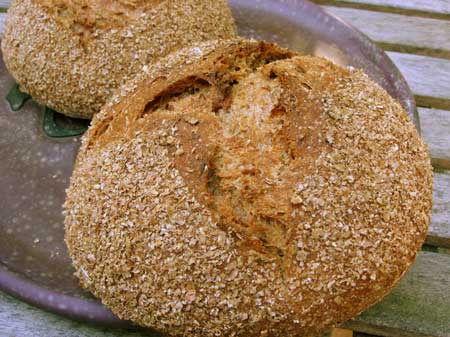
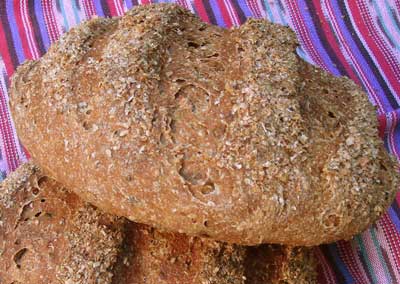
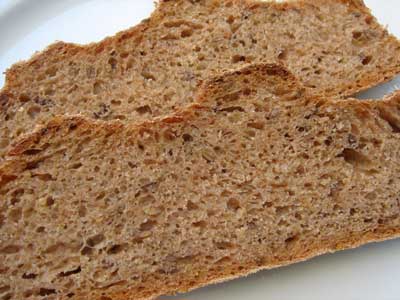
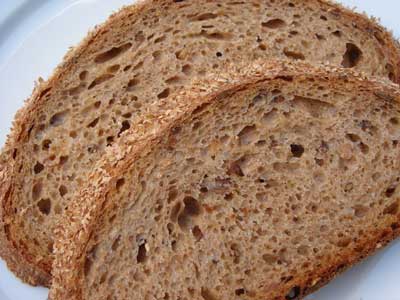
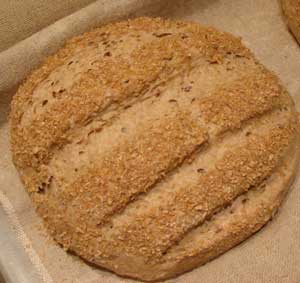
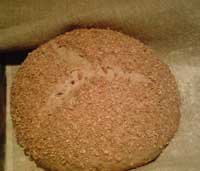
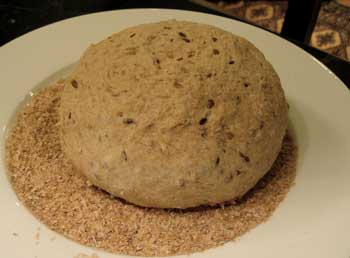
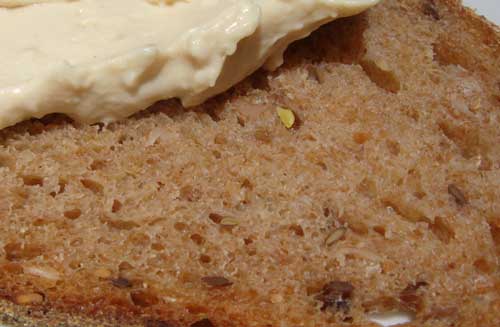
It must be something to do with September! I just overproofed TWO loaves of sourdough the other day as well.
The dough was taking much longer to rise than I expected – cooler day – so silly me, I put it in the oven with the light turned on to warm it up a little. And then forgot. Even though it had at least tripled (if not more) I imagined that it would all be all right if I just shaped it. Ha. What were supposed to be boules ended up looking more like ciabatti and are almost flat as pancakes.
But I’m very glad to hear that your “so-so” bread tasted great. I’m hoping we have the same experience tonight with the so-so bread I made. But just in case, we’re opening a decent bottle of wine to drown our sorrows if it’s not so good.
-Elizabeth
Elizabeth, I hope it was good (the bread and the wine)!
It has to be this time of year. I over-proofed my sourdough loaves last week as well. Today, no problem…even has the perfect crust. Your loaf is gorgeous!
Thanks for the post.
I think I slash my bread quite deep then I always get your so-so bread result especially whole grain and rye bread. Susan, your breads always look so beautiful.
I’m happy to report that they were both very good. The wine was crafted MUCH better than the bread…. (What wine, you ask? Gevrey Chambertin Lavaut St.Jacques 1990 – lucky us!! We would probably never pay that much for a bottle of wine now but we have a few bottles left in our stash from when we were collecting. The taste took us right back to our bicycle trip through Burgundy in 1996. On the day we rode through Gevrey, there was harvest festival going on and we tasted the most wonderful wine – fruit cake and plum on the nose. I was so thrilled to get that similar hint of fruit cake and plums with the 1990!)
-Elizabeth
Tartelette, I agree with you and Elizabeth — September can’t decide if it wants to be summer or fall, and subjects us all to its whims…
Kim, even flat-ish home-baked bread is ten times better than store-bought, don’t you think?
Elizabeth , the wine and the trip sound great!
Hi all,
I really need help with bakers percentages and preferments, any ideas?
Gena Lora, stay tuned for Part 4 of my baker’s percentage tutorial.
I just made this bread and it’s so good… It didn’t rise too much (not even double the volume, I don’t think). I am not sure if it is supposed to rise more than what I had. Today’s also quite cold, so that maybe contribute to that. Anyway, when I cut into it, it still has beautiful small holes and spongy texture. And it’s so nutty because of the soaker ingredients. Yum!
Thanks!
Fruit Cakes are the specialty of my grandmother, she bakes lots of fruit cakes.`:*
fruit cakes with lots of raisins is the thing that i often much, they are great and yummy;””
my sister always bake fruit cakes coz we always love to much them at night’:*
Susan,
My sincere thanks for your efforts in this blog. It has changed my life. My Economists and WSJs have been neglected because…..I can’t stop baking and reading about baking.
With this bread (and the other full rye, whole wheat ones) I am not getting an open crumb (as in your pictures) or even half the size of the air pockets as in the Norwich sourdough. My kitchen, flour and water are at 75 degrees, and my starter is happy and full of life. I usually begin 8 hours after feeding, she’s more than doubled, smells tart, tastes tangy but with no alcohol. Is this too long to wait? I’m careful not to over knead or proof keeping the gluten development low to medium. Any thoughts?
Many thanks Susan,
Sam
Sam, 8 hours is not too long to wait if your starter is fed twice a day. Make sure you are not proofing too long, as I did with this one the first time around. Also, it could be that you are actually not mixing (kneading) long enough — if the gluten is too weak it will not support a good crumb structure.
Susan Hi,
Love your blog!
I’ve tried making this bread today, It’s in the oven right now and so far it seems that the results are quite poor… although the dough have about doubled in size after the first ferment it was not at all firm after the second shaping or after proofing… it appears that it’s going to come out all pita-like. What could be the cause? is it un-developed gluten? maybe not a lively enough starter? is there anything that can help with making a more airy whole-wheat bread? I’ve been struggling with that for quite some time.
Thanks,
Neta.
who doesnt love to munch fruit cakes, they are really great.’
Make sure you visit our own blog page too
http://www.prettygoddess.com/index.php?board=8.0
Hi Susan,
Question: why score the loaves before the final proof in this recipe? I’ve always thought that you’re supposed to score the loaves just before you put them in the oven.
Thanks,
Andrew
Nevermind. I just bothered to read the rest of the blog entry above the recipe and saw the explanation.
why is it better to score before proving? i have a recipe for a grain loaf that says the same thing but i thought it made no sense!
I have been making this bread for several years now. I like to make it much more seedy(?). I add pumpkin seeds and just throw in lot more of the other seeds. I love the way it turns out, chewy, seedy and delicious with little bubble holes. Sometimes it’s kind of flat. I use a rye started that I have. Should I add more starter to compensate for the added weight of the seeds?